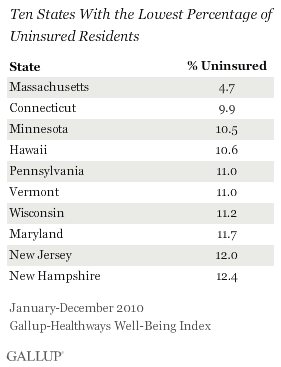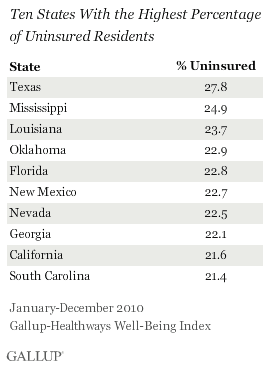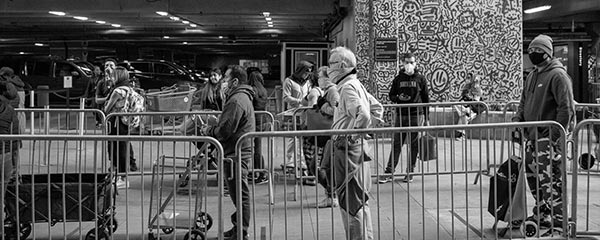WASHINGTON, D.C. -- Nearly 3 in 10 adults living in Texas (27.8%) do not have health insurance, making it the state with the highest uninsured rate in the country in 2010. Mississippi and Louisiana also have high rates of uninsured residents, with about one in four lacking coverage. By a significant margin, Massachusetts -- where state law requires all adult residents to have health insurance -- continues to have the lowest percentage of uninsured residents, at 4.7%. Connecticut, Minnesota, and Hawaii also have relatively low uninsured rates, with about 1 in 10 adults not carrying health insurance in each.


These state-level data are based on daily surveys conducted as part of the Gallup-Healthways Well-Being Index from January through December 2010, encompassing more than 350,000 interviews with American adults. Gallup and Healthways began daily tracking of American adults' health insurance coverage in January 2008. At the national level, 16.4% of adults were uninsured in 2010, statistically unchanged from 16.2% in 2009, but up from 14.8% in 2008.
 |
| Explore complete state data > |
Uninsured Population Highest in the South and the West
Southern and Western states have a disproportionately large percentage of uninsured residents, as they did in 2009 and 2008. This geographic pattern is likely tied at least in part to these states' larger Hispanic populations. Gallup finds Hispanic Americans are the demographic group most likely to be uninsured in the United States, at 38.9% in 2010.
Seven out of the 10 states with the fewest uninsured residents are in the Northeast, similar to past years.

Uninsured Rates Up or Unchanged in Most States in 2010
Most states saw a rise or no change in the percentage of uninsured residents in 2010 compared with 2009. Wyoming was the lone state where the uninsured rate decreased to a significant degree in 2010. More Americans in almost all states, however, were uninsured in 2010 than in 2008. For example, the percentage of adults without healthcare coverage in Texas rose from 25% in 2008 to 27.8% in 2010. The uninsured rate is up the most since 2008 in Kentucky, Utah, Florida, and Louisiana.

Bottom Line
Nationwide, Gallup has measured a decrease in employer-based based healthcare and an increase in government health insurance, which includes Medicaid, Medicare, and military/veterans' coverage, since 2008. As long as unemployment remains high, the percentage of Americans who get health insurance from an employer is unlikely to increase. The increase in government healthcare, which Gallup finds across all age groups, is causing financial problems for states when they are already grappling with reduced revenues. Many states are now looking to cut back on government-funded health services with an eye on Medicaid programs in particular, which serve some low-income Americans, a group that is among the most likely to be uninsured. Depending on the extent of states' cuts to Medicaid and the overall economic situation in the United States, the uninsured population could grow in 2011.
The new healthcare law, which seeks to expand coverage, may fill the voids in care that state budget troubles and unemployment are creating. However, the government will not fully implement all pieces of the legislation until 2014, and many of the new programs could take time to ramp up.
Gallup's "State of the States" series reveals state-by-state differences on political, economic, and well-being measures Gallup tracks each day.
About the Gallup-Healthways Well-Being Index
The Gallup-Healthways Well-Being Index tracks U.S. well-being and provides best-in-class solutions for a healthier world. To learn more, please visit well-beingindex.com.
Survey Methods
Results are based on telephone interviews conducted as part of the Gallup-Healthways Well-Being Index survey Jan. 2-Dec. 29, 2010, with a random sample of 352,840 adults, aged 18 and older, living in all 50 U.S. states and the District of Columbia, selected using random-digit-dial sampling.
For results based on the total sample of national adults, one can say with 95% confidence that the maximum margin of sampling error is ±1 percentage point.
The margin of sampling error for most states is ±1 to ±2 percentage points, but is as high as ±4 points for states with smaller population sizes such as Wyoming, North Dakota, South Dakota, Delaware, and Hawaii.
The Gallup-Healthways Well-Being Index categories the District of Columbia as a congressional district.
Interviews are conducted with respondents on landline telephones and cellular phones, with interviews conducted in Spanish for respondents who are primarily Spanish-speaking. Each daily sample includes a minimum quota of 200 cell phone respondents and 800 landline respondents, with additional minimum quotas among landline respondents for gender within region. Landline respondents are chosen at random within each household on the basis of which member had the most recent birthday.
Samples are weighted by gender, age, race, Hispanic ethnicity, education, region, adults in the household, cell phone-only status, cell phone-mostly status, and phone lines. Demographic weighting targets are based on the March 2010 Current Population Survey figures for the aged 18 and older non-institutionalized population living in U.S. telephone households. All reported margins of sampling error include the computed design effects for weighting and sample design.
In addition to sampling error, question wording and practical difficulties in conducting surveys can introduce error or bias into the findings of public opinion polls.
For more details on Gallup's polling methodology, visit www.gallup.com.
